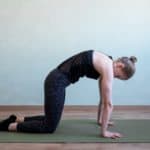You’re pregnant–congratulations! But with all the joys of bringing new life into the world come a lot of other things too, including fear, pain, anxiety… and everyone’s got an opinion on what you should be doing.
And that includes what you “can” and “can’t” do while exercising.
One of the reasons we’ve had so many pregnant clients come to us is that we’re known for our practical, mindful approach to training–which is exactly what you’ll find in this article.

We’ll clear up common myths, help you find an approach that makes sense for your particular circumstances, and give you some proven exercises for addressing a lot of the most common issues women face during pregnancy.
As a physical therapist for 20+ years, I’ve worked with many pregnant women, but I enlisted the help of two of our other staff members in putting together this guide.
- Rose Calucchia (GMB Lead Trainer and client support) is certified in pre- and post-natal training, and has worked with dozens of pregnant clients.
- We originally put this guide together when another member of our client support team, Jenn Wood, was pregnant with twins and dealing with the aches and pains that come along with growing two people in your belly. Having that first-hand experience helped us make this guide as complete as possible.
No matter what stage you’re at in your pregnancy (or post-pregnancy), this guide will help you manage aches and pains, maintain your strength and mobility, and regain strength and mobility following the birth of your baby.
Training Concerns at Different Stages of Pregnancy
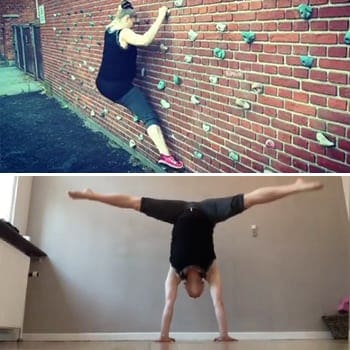 A lot of the ideas people have about what “can” and “can’t” be done during pregnancy are, frankly, outdated.
A lot of the ideas people have about what “can” and “can’t” be done during pregnancy are, frankly, outdated.
Doctors used to caution pregnant women about lifting heavy things or exerting themselves more than absolutely necessary, but we now know that exercise during pregnancy can be very beneficial.
Still, growing a human takes a lot of work, and your training (as well as many other parts of your life) will likely need to be adjusted as you move through different stages. Whether this is your first pregnancy or you’ve been down this road before, pregnancy is 9+ months of constant change for your body, so you’ll have different challenges at different stages.
Here are some general guidelines that apply throughout pregnancy, before we get into the specifics of each trimester:
- Avoid activities that will cause compression or trauma to the abdomen.
- If you are not already pretty experienced in inversion exercises (like handstands), it’s not recommended to begin those types of activities during pregnancy.
- High impact activities, like jumping or sprinting, are not a great idea during pregnancy.
- Pay close attention to your energy levels, and how quickly you fatigue.
- Be aware that you may have sudden changes in your blood pressure and/or blood sugar.
It’s extremely important that you speak with your OB/GYN, midwife, or other maternity care provider about your particular situation, and follow his/her recommendations, but these general guidelines, and the more detailed recommendations below, should be accepted by most maternity care providers for most healthy, uncomplicated pregnancies.
Fitness Training in the First Trimester
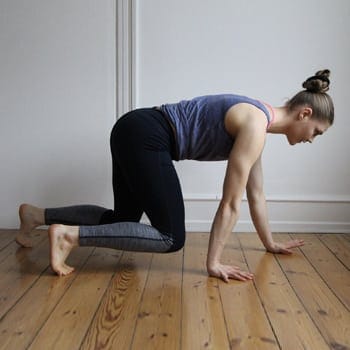 For many women, training during the first trimester can be quite a challenge, as nausea and fatigue are so predominant.
For many women, training during the first trimester can be quite a challenge, as nausea and fatigue are so predominant.
But if you are able to, it’s a good idea to continue doing whatever training you had done before getting pregnant. Just be careful to take more breaks as needed, and pay attention to how you are feeling.
If you were not on a training program before getting pregnant, or if you are struggling with training around first trimester symptoms, we recommend doing as much as you can, even if that just means walking 30 minutes per day or doing some gentle locomotion exercises for a few minutes when you can.
Keep moving throughout your first trimester (as much as possible), and it’ll make training during the second trimester much more doable.
Exercising in the Second Trimester
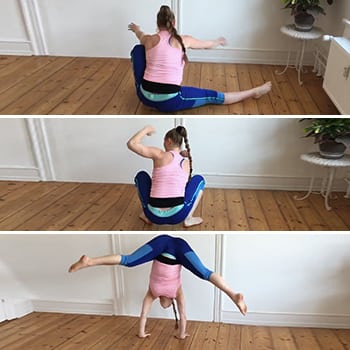 The second trimester is often referred to as the “honeymoon period”–it’s when most women feel their best. Those difficult symptoms of the first trimester usually subside, and most women can resume their regular activities.
The second trimester is often referred to as the “honeymoon period”–it’s when most women feel their best. Those difficult symptoms of the first trimester usually subside, and most women can resume their regular activities.
Training during this stage can be pretty crucial, since it’s your best opportunity to build the strength you need to support your body through these changes.
If you did serious training before you got pregnant, but had to take a break during your first trimester, now is the time to get back to your normal training, although you should not expect to ramp things up too much at this time. Maintaining a baseline is a great goal at this stage.
If you did not train at all before you got pregnant, you should continue walking, and maybe add in some strength training under the supervision of a trainer with prenatal experience.
Higher levels of relaxin in the body during pregnancy means that strength training is even more important during pregnancy.
Fitness Training in the Third Trimester
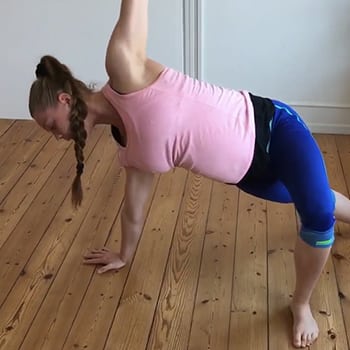 As you enter your third trimester, you’ll likely face some new challenges. As the belly grows, it becomes more difficult for many women to maneuver their bodies around, and it’s very common to experience new aches and pains, especially in the back, hips, and pelvis.
As you enter your third trimester, you’ll likely face some new challenges. As the belly grows, it becomes more difficult for many women to maneuver their bodies around, and it’s very common to experience new aches and pains, especially in the back, hips, and pelvis.
And that makes sense because there’s a lot of new pressure being placed on the pelvis and surrounding areas, in a relatively short period of time.
Many women continue their regular training up until the very end of pregnancy, but others find they have to slow down or make adjustments. It’s important to be mindful of how you’re feeling and not to push yourself too hard during this time.
The exercises further down in this article will be especially helpful during late pregnancy.
Post-Natal Fitness Training Concerns
Of course, after you give birth, you’re faced with a whole new set of challenges!
During the first few weeks and months, in addition to the changes your body has gone through and will continue to go through, you’ll have some new challenges that can make training difficult, including lack of sleep, carrying around a newborn, and hormonal changes.
But in most cases, the sooner you can get back to moving around after you give birth, the better.
Again, even if that just means starting to walk around the block with your baby, or doing some stretches in your living room while the baby naps, it’ll help you get back to feeling and moving the way you did pre-pregnancy.
And continuing to train throughout your pregnancy will help you bounce back even quicker, so it’s definitely recommended.
Common Aches and Pains During Pregnancy
Now that we covered some general concerns at different stages of pregnancy, let’s go into some more detail on specific aches and pains many women experience during pregnancy:
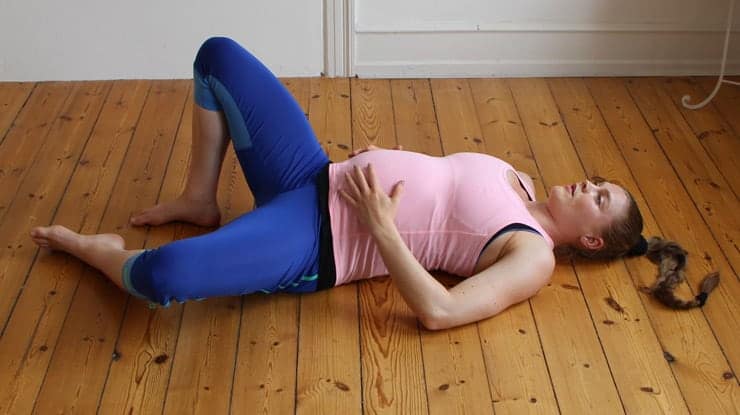
Pelvic Pain
Pelvic pain can be relatively complex and includes anterior and posterior pelvic pain.
Anterior pelvic pain includes the pubic symphysis, while posterior pelvic pain includes the sacroiliac (S-I) joint, piriformis (and other hip rotator) muscle pain, as well as sciatic nerve pain.
- General Recommendations: Do exercises #2, 4, and 5 in the routine below, and focus on kegels and abdominal bracing. An S-I belt can also be very helpful.
Round Ligament Pain
Round ligament pain, a sharp pain in the lower belly or groin, can occur when moving around from one position to another (in general for some women, while for others, it only happens when shifting positions quickly).
- General Recommendations: If you feel this type of pain while getting up from lying down, try slowing down your transitions. You can also try spending a minute lying on your side first before sitting up.
Carpal Tunnel
While we often think of carpal tunnel syndrome as being associated with too much keyboard time, it’s very common in pregnancy. It can be caused by the combination of swelling and hormonal changes that affect ligament laxity.
- General Recommendations: Work on our wrist routine to improve strength and mobility in the wrists.
Low Back Pain
Low back pain is incredibly common in pregnancy, either as an exacerbation of older issues, or due to all the changes occurring with pregnancy.
It can be caused by any combination of the following: weight increase; body changes that affect your normal walking patterns and the way you lift and carry things; ligament laxity; and decreased core strength due to stretching of the abdomen.
- General Recommendations: All of the exercises in the routine below will be helpful. Plus, lying down on your right side with a pillow between the legs is a good position of ease for most.
Overall Joint Pain
The release of a hormone called relaxin throughout pregnancy makes the ligaments more lax. This can cause current or past issues to worsen, and can bring up new issues as well.
Stretches and other exercises that take you past certain ranges of motion could cause you pain. So, in general, don’t hold stretches for as long (no longer than a minute or so), and don’t push too far into stretches.
Since pain can be delayed and not necessarily felt while you’re doing the exercises, it’s best to err on the side of caution and back off before you think you need to.
- General Recommendations: All of the exercises in the routine below will be good to practice, just make sure to focus on backing off sooner than you might think.
Exercises to Relieve Pregnancy Aches and Pains
The following exercises can be especially helpful later in pregnancy, but starting them earlier in your pregnancy could potentially prevent or minimize many common aches and pains.
GMB Trainer Edith Maria is nearing the end of her first pregnancy, and she graciously agreed to film these exercises for us. She’s been training and moving throughout her pregnancy, and at the end of the video, she demonstrates some of the things she’s been able to continue doing, even later in pregnancy.
1. Marching in Shoulder Bridge
- Start lying on your back with your knees bent (feet should be about hip-width apart), and your arms at your sides.
- Lift the hips up off the ground, but only go as far as is comfortable, and don’t arch the back.
- Keep the hips and pelvis stable as you begin to march your feet in place, slowly lifting and lowering one leg at a time. You don’t need to lift the feet as high as Edith demonstrates in the video–a slight lift is sufficient.
2. Piriformis/Glute Stretch on Support
- Stand in front of a support–any table or chair is fine–and lift one leg up onto the support, bending the knee to 90 degrees.
- Keep chest up and, bending at the hips, lean your body forward over your leg.
- Only go as far as you can without pain or discomfort. You should feel a nice stretch on your bent leg glute and thigh.
- Repeat on the other side.
3. Supported Forward Bend
- Stand in front of a support–any raised surface is fine.
- Bend forward from your hips, keeping your back nice and flat, and place your arms on the support.
- Push your hips back and you can practice shifting from side to side, back and forth, etc., just whatever feels most comfortable.
4. Hip Rotation Resting Position
- Lie on your back with your knees bent. Let one knee fall to the side, which will open up the pelvis nicely.
- Stay in this position for a minute or so, or as long as it feels comfortable and relieving. Be sure to do this stretch on both sides.
5. Hip Flexor Stretch
- Lie down on an elevated surface (a couch or bed is fine) so that one leg can hang off the end.
- Bend the other knee in to your chest to stretch the hip.
- Hold for a minute or two, then repeat on the other side.
FAQs About Fitness Training During Pregnancy
Pregnancy–especially if it’s your first pregnancy–can bring up many questions. You want to make sure you’re being safe, but you also don’t want the changes in your body to keep you from doing the things you love during and after pregnancy.
We addressed a lot of common concerns above, but we’ve answered some further questions here.
Is it safe for me to run / lift weights / do handstands / practice martial arts / (fill in the blank) during pregnancy?
The general rule of thumb is, if you were doing a particular activity before getting pregnant, you can continue that activity while pregnant. The same ideas listed above apply, however, and you may need to make certain adjustments or back off a bit as needed.
If you were not practicing these particular activities before getting pregnant, it’s not a great idea to begin activities that include inversions or higher impact exercise.
Since many of our clients practice various forms of martial arts, it’s worth noting about martial arts in particular, that it’s fine to continue whatever you were doing before getting pregnant, but just be careful to avoid any impact to your abdomen or high impact throws in general. And make sure you are only working with training partners you can trust will go easy on you.
As always, check with your OB/GYN, midwife, or other maternity care provider to confirm that specific activities are okay for you during your pregnancy.
Should I be doing prenatal yoga?
Prenatal yoga is super popular, and it can be great for many people. But you shouldn’t feel like you have to do it if you don’t enjoy it. Working on the exercises we shared in this article, along with continuing to move throughout your pregnancy, will help you get most of the benefits you’d likely get from doing prenatal yoga.
Can I work on GMB programs during pregnancy?
Again, always ask your OB/GYN, midwife, or other maternity care provider about your particular circumstances, but it’s likely that your doctor will confirm that you should be active and continue to exercise during pregnancy–especially early on.
The main things you need to be wary of when it comes to exercising during pregnancy won’t happen until later on, and during the first and second trimesters you should be able to do pretty much everything you normally do, including GMB programs.
Elements is the program we typically recommend for our pregnant clients, as it emphasizes controlled, mindful, and gentle exercises. You will be completely safe to do these movements during pregnancy, as long as you emphasize good form and don’t push yourself into high levels of fatigue.
We caution against doing inversions (high frogger and bear variations) later on in the program, because as your belly grows, your balance will likely be off as your center of gravity shifts.
How can I bounce back quickly after pregnancy?
There are two primary issues most people are concerned about when they ask this question:
- Function–You want to know how quickly you can get back to doing what you could do before pregnancy.
- Physique–You want to know how to quickly shed the extra pounds you’ve put on during pregnancy.
These are both very valid concerns.
For the first–function–the best way to get back to doing what you could do before pregnancy, or to regain strength and mobility after you give birth, is to continue training and moving throughout your pregnancy. Even if you’re doing less during pregnancy, you’ll bounce back to your previous function fairly quickly.
As for physique, getting your nutrition dialed in as much as possible, while maintaining a healthy training regimen, will help you get there.
The key, though, is to be realistic and patient. The first couple of months of your baby’s life are the hardest, so by the time you start feeling a little more like “yourself,” your body will have gone through almost a year of major changes. That’s a lot!
Be patient with yourself. You may not “bounce back” like the celebrities do 3 days after giving birth, but that’s okay (and probably healthier in the long term).
If you have more specific questions about your particular situation, definitely speak to your OB/GYN, but we’re happy to help if we can, so email us anytime 🙂
Keep Your Body Healthy at Any Life Stage!
Keeping your body moving well, and feeling strong and capable, is important no matter your current life stage. Whether you’re pregnant, recently had a baby, or never plan to have kids, you rely on your body every day, so you need to make sure it can do what you ask of it.
Our Elements program will help you build a foundation of strength, mobility, and body control, and is safe to work on regardless of your current life stage.
It’s our most popular program for our pregnant clients, but works well for anyone 🙂
Maintain a Strong Body
Elements will help you keep moving well and feeling strong throughout your pregnancy and beyond. Building this foundation will help you get back to your pre-baby function in no time.
The strategies in this article will take you far, and they work well alongside our free Body Maintenance Guide. If you have specific areas you’re concerned about keeping healthy and moving well, the Body Maintenance Guide will help you address those head-on.
Got something to say? Join the discussion over on Facebook.



